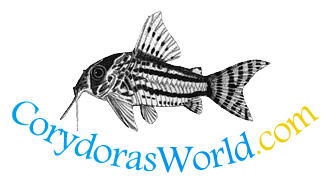avoid egg-fungus
- Sid Guppy
- Posts: 757
- Joined: 31 Dec 2002, 15:36
- Location 1: Brabant, the Netherlands
- Interests: Catfish, Tanganyikan fish, Rock'n'roll, Fantasy
avoid egg-fungus
Just a question for the more experienced Corydoras-breeders: what do you do or use to avoid the eggs from being destroyed by fungus?
-Chemicals, and wich one?
-snails, and wich species?
-nothing?
-removing bad eggs, and how? (tweezers? coctailsticks? etc)
-Chemicals, and wich one?
-snails, and wich species?
-nothing?
-removing bad eggs, and how? (tweezers? coctailsticks? etc)
Plan B should not automatically be twice as much explosives as Plan A
- Dinyar
- Posts: 1286
- Joined: 31 Dec 2002, 00:34
- My articles: 3
- My images: 227
- My catfish: 10
- My cats species list: 3 (i:10, k:0)
- Spotted: 94
- Location 1: New York, NY, USA
- Interests: Mochokidae, Claroteidae, Bagridae, Malepteruridae, Chacidae, Heteropneustidae, Clariidae, Sisoridae, Loricariiadae
- Coryman
- Expert
- Posts: 2119
- Joined: 30 Dec 2002, 19:06
- My articles: 12
- My catfish: 5
- My cats species list: 83 (i:5, k:0)
- My BLogs: 1 (i:0, p:1)
- Spotted: 194
- Location 1: Kidderminster UK
- Location 2: Kidderminster, UK
- Interests: Cory's, Loricariids, photography and more Cory's
- Contact:
- Sid Guppy
- Posts: 757
- Joined: 31 Dec 2002, 15:36
- Location 1: Brabant, the Netherlands
- Interests: Catfish, Tanganyikan fish, Rock'n'roll, Fantasy
Any of you used acyiflavine, and perhaps can tell me the concentration? I've got the pure powder in a jar, and I know that one should use tiny amounts, but nothing more than that.....
i've got Hoplosternum 'X'- eggs & fry (try-out #3 so far); from try out #1 only 1 still lives, and try out #2 was one big failure....
And that fry doesn't eat microworms so far.
do you know when the fry begins to feed? one, two or three days (or even later) after hatching? I take it, they behave like corydoras fry; the outlook and size are similar to say; paleatus-fry.
i've got Hoplosternum 'X'- eggs & fry (try-out #3 so far); from try out #1 only 1 still lives, and try out #2 was one big failure....
And that fry doesn't eat microworms so far.
do you know when the fry begins to feed? one, two or three days (or even later) after hatching? I take it, they behave like corydoras fry; the outlook and size are similar to say; paleatus-fry.
Plan B should not automatically be twice as much explosives as Plan A
-
Achim
- Posts: 137
- Joined: 01 Jan 2003, 18:31
- Location 1: Europe, Germany,federal state Hessen, Marburg, Lahn river.
- Interests: south american catfish, catfish in general, ostariophysi in general.
- Contact:
Hi,
i mostly use aldercones. The humidic acid ("Huminsäure" in german, i don't know if humidic acid is the right word...) lowers the pH slightly and humidic acids themselves act bactericide and lower the germination number ("keimzahl" in german, d*mn i need a scientific dictionary...) in general. Its mainly bacteria and protozoa that mortify eggs, fungy settle secondarily when the eggs are already dead or weakened.
Aldercones work for example well for C. gossei, C. concolor, C. cf. axelrodi. The concentration depends on the species. In case of C. concolor the water can be coloured deeply brown (that species originates from waters with low pH anyway), whereas C. gossei eggs die at such high concentrations. The water should only have the colour of tea in that case (The experience what concentraion is right comes with time...).
In case of long-snouted Corydoras (C. cervinus etc.) i dont use anything to prevent destruction by bakteria protozoa etc. though i made the experience that they are quite immune to that.
In case aldercones and doing nothing doesn't work i try lowering the pH and/or lowering conductivity (most Cory with sensitive eggs come from waters with low pH and/or low conductivity = low germination number).
If aldercones and adjusting water values don't work (or if im too lazy to adjust water values i use Acriflavin.
i use Acriflavin.
Greetings... Achim
i mostly use aldercones. The humidic acid ("Huminsäure" in german, i don't know if humidic acid is the right word...) lowers the pH slightly and humidic acids themselves act bactericide and lower the germination number ("keimzahl" in german, d*mn i need a scientific dictionary...) in general. Its mainly bacteria and protozoa that mortify eggs, fungy settle secondarily when the eggs are already dead or weakened.
Aldercones work for example well for C. gossei, C. concolor, C. cf. axelrodi. The concentration depends on the species. In case of C. concolor the water can be coloured deeply brown (that species originates from waters with low pH anyway), whereas C. gossei eggs die at such high concentrations. The water should only have the colour of tea in that case (The experience what concentraion is right comes with time...).
In case of long-snouted Corydoras (C. cervinus etc.) i dont use anything to prevent destruction by bakteria protozoa etc. though i made the experience that they are quite immune to that.
In case aldercones and doing nothing doesn't work i try lowering the pH and/or lowering conductivity (most Cory with sensitive eggs come from waters with low pH and/or low conductivity = low germination number).
If aldercones and adjusting water values don't work (or if im too lazy to adjust water values
Greetings... Achim
- Bathos
- Posts: 80
- Joined: 09 Jan 2003, 13:09
- I've donated: $20.00!
- Location 1: USA, Pennsylvania
- Interests: Corydoras and other freshwater fish
- Silurus
- Posts: 12420
- Joined: 31 Dec 2002, 11:35
- I've donated: $12.00!
- My articles: 55
- My images: 893
- My catfish: 1
- My cats species list: 90 (i:1, k:0)
- Spotted: 424
- Location 1: Singapore
- Location 2: Moderator Emeritus







